Kenneth Grahame
Kenneth Grahame (/ˈɡreɪ.əm/ GRAY-əm; 8 March 1859 – 6 July 1932) was a Scottish writer, most famous for The Wind in the Willows (1908), one of the classics of children's literature. He also wrote The Reluctant Dragon. Both books were later adapted for stage and film, of which A. A. Milne's Toad of Toad Hall, based on part of The Wind in the Willows, was the first. Other adaptations include the Disney films The Adventures of Ichabod and Mr. Toad and The Reluctant Dragon.
Kenneth Grahame | |
|---|---|
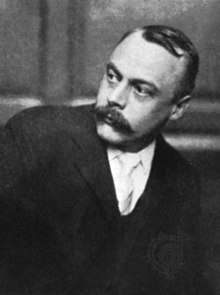 Kenneth Grahame in 1910 | |
| Born | 8 March 1859 Edinburgh, Scotland, UK |
| Died | 6 July 1932 (aged 73) Pangbourne, England, UK |
| Occupation |
|
| Genre | Fiction |
| Notable works | The Wind in the Willows (1908) |
Personal life
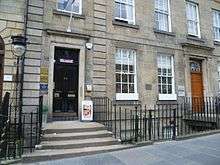
Early life
Kenneth Grahame was born on 8 March 1859 in Edinburgh, Scotland. When he was a little more than a year old, his father, an advocate, received an appointment as sheriff-substitute in Argyllshire at Inveraray on Loch Fyne. When he was five, his mother died of puerperal fever,[1] and his father, who had a drinking problem, gave over care of Kenneth, his brother Willie, his sister Helen and the new baby Roland to Granny Ingles, the children's grandmother, in Cookham Dean in the village of Cookham in Berkshire.
There the children lived in a spacious, dilapidated house called The Mount, in expansive grounds, and were introduced to the riverside and boating by their uncle, David Ingles, who was a curate at Cookham Dean church. This ambience, particularly Quarry Wood and the River Thames, is believed by Grahame's biographer Peter Green to have inspired the setting for The Wind in the Willows.[2]
Grahame was an outstanding pupil at St Edward's School, Oxford. In his early years there, no sports regimen had been established and the boys were free to explore the old city and its surroundings.[3]
Career
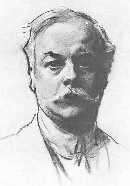
Grahame wanted to attend Oxford University, but was not allowed to do so by his guardian on grounds of cost. Instead he was sent to work at the Bank of England in 1879, and rose through the ranks until retiring as its Secretary in 1908 due to ill health,[4] which may have been precipitated by a possibly political shooting incident at the bank in 1903. Grahame was shot at three times, but all the shots missed him.[5]
An alternative explanation, given in a letter on display in the Bank museum, is that he had quarrelled with Walter Cunliffe, one of the bank's directors, who would later become Governor of the Bank of England, in the course of which he was heard to say that Cunliffe was "no gentleman". His retirement was enforced ostensibly on health grounds. He was awarded an annual pension of £400, but a worked example on display indicates he was actually due to receive £710.[6]
Marriage and fatherhood
Grahame married Elspeth Thomson, the daughter of Robert William Thomson in 1899. They had one child, a boy named Alastair (nicknamed "Mouse"), who was born blind in one eye and plagued by health problems throughout a short life. On Grahame's retirement, the family returned to Cookham, his childhood home, where they lived at Mayfield, now Herries Preparatory School. There Grahame produced bedtime stories that he told Alastair and turned into The Wind in the Willows.[7] Alastair took his own life on a railway track while an undergraduate at Oxford University, five days before his 20th birthday on 7 May 1920.[8] His demise was recorded as an accidental death out of respect for his father.
According to Cardiff University Professor Emeritus Peter Hunt, Grahame shared a house in London with a set designer, W. Graham Robertson, while Grahame's wife and son lived in Berkshire.[9]
Death
Grahame died in Pangbourne, Berkshire, in 1932. He is buried in Holywell Cemetery, Oxford. Grahame's cousin Anthony Hope, also a successful author, wrote him an epitaph: "To the beautiful memory of Kenneth Grahame, husband of Elspeth and father of Alastair, who passed the river on the 6th of July, 1932, leaving childhood and literature through him the more blest for all time."[10]
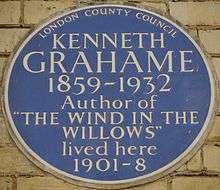 Blue plaque, 16 Phillimore Place, London, home during 1901–1908
Blue plaque, 16 Phillimore Place, London, home during 1901–1908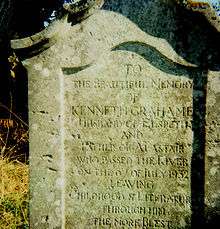 Grahame's headstone in Holywell Cemetery, Oxford
Grahame's headstone in Holywell Cemetery, Oxford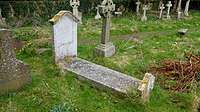 Grahame's grave at Holywell Cemetery, Oxford
Grahame's grave at Holywell Cemetery, Oxford
Writing
While still a young man in his twenties, Grahame began to publish light stories in London periodicals such as the St. James Gazette. Some of these were collected and published as Pagan Papers in 1893, and two years later The Golden Age. These were followed by Dream Days in 1898, which contains The Reluctant Dragon.
There is a ten-year gap between Grahame's penultimate book and the publication of his triumph, The Wind in the Willows. During that decade, Grahame became a father. The wayward, headstrong nature he saw in his little son Alastair he transformed into the swaggering Mr. Toad, one of its four principal characters. The character in the book known as Ratty was inspired by his good friend, and writer, Sir Arthur Quiller-Couch. Grahame mentions this in a signed copy he gave to Quiller-Couch's daughter, Foy Felicia.[11] Despite its success, he never attempted a sequel. The book is still widely enjoyed by adults and children.[12] It has given rise to many film and television adaptations, while Toad remains one of the most celebrated and beloved characters in children's literature. In 1929, A. A. Milne wrote the play Toad of Toad Hall, which is based on part of The Wind in the Willows, which won the Lewis Carroll Shelf Award in 1958. In the 1990s, William Horwood produced a series of sequels.
Works
- Pagan Papers (1893)
- The Golden Age (1895)
- Dream Days (1898), including "The Reluctant Dragon" (1898)
- The Headswoman (1898)
- The Wind in the Willows (1908), illustrated by Ernest H. Shepard
- Bertie's Escapade (1949), illustrated by Ernest H. Shepard
References
- Peter Hunt, "Grahame, Kenneth (1859–1932)", Oxford Dictionary of National Biography (Oxford, UK: OUP, 2004) retrieved 8 July 2016.
- Green, Peter (1983). "Chapter 1: Dragons and Pterodactyles 1859–67". Beyond the Wild Wood: The World of Kenneth Grahame Author of The Wind in the Willows. New York: Facts on File. pp. 9–24. ISBN 0-87196-740-5.
- Green, Peter (1983). "Chapter 2: The Spell of Oxford". Beyond the Wild Wood: The World of Kenneth Grahame Author of The Wind in the Willows. New York: Facts on File. pp. 29–40. ISBN 0-87196-740-5.
- "From Quill Pen to Computer: The Bank of England's Staff from 1694". Bank of England Museum. Archived from the original on 21 February 2009. Retrieved 3 May 2009.
- John Preston (8 February 2008). "Kenneth Grahame: Lost in the wild wood". Telegraph.co.uk. Retrieved 3 May 2009.
- "Bank of England Museum". Archived from the original on 7 April 2014. Retrieved 3 April 2014.
- Robin & Valerie Bootle (1990). The Story of Cookham. private, Cookham. p. 188. ISBN 0-9516276-0-0.
- "Biography". Kenneth Grahame Society. Archived from the original on 14 February 2015. Retrieved 3 May 2009.
- McCormick, Joseph Patrick (28 January 2018). "Scholar says The Wind in the Willows can be read as a "gay manifesto"". PinkNews. Retrieved 29 January 2018.
- Carpenter, Humphrey; Mari Prichard (1991). The Oxford Companion to Children's Literature. Oxford: Oxford University Press. pp. 216–219. ISBN 0-19-211582-0.
- Auctioned by Bonhams on Tuesday 23 March 2010 for £32,400: Flood, Alison (24 March 2010). "First edition of The Wind in the Willows sells for £32,400". The Guardian. London. Archived from the original on 26 March 2010. Retrieved 25 March 2010.
- "Newsweek's Top 100 Books: The Meta-List". Retrieved 3 June 2010.
Further reading
- Green, Peter, the historian of Hellenistic Greece, wrote a biography of Grahame, Kenneth Grahame 1859–1932. A Study of His Life, Work and Times in 1959, with black and white illustrations, and subsequently wrote the introduction to the Oxford World's Classics edition of The Wind in the Willows. Several abridged versions of the biography with added color illustrations were published in the United States and Britain 1982 to 1993 under the title Beyond the Wild Wood: The World of Kenneth Grahame Author of The Wind in the Willows ISBN 0-87196-740-5 and ISBN 1-85627-336-9
- K. Grahame, The Annotated Wind in the Willows, edited with preface and notes by Annie Gauger and Brian Jacques, Norton, ISBN 978-0-393-05774-4.
- K. Grahame, The Wind in the Willows: An Annotated Edition, edited by Seth Lerer. Belknap Press/Harvard University Press, ISBN 978-0-674-03447-1.
- Alison Prince: Kenneth Grahame: An Innocent in the Wild Wood, London: Allison & Busby, 1994, ISBN 0-85031-829-7
- Wullschläger, Jackie (2001) [1995]. Inventing Wonderland: The Lives of Lewis Carroll, Edward Lear, J. M. Barrie, Kenneth Grahame, and A. A. Milne. London: Methuen. ISBN 978-0-413-70330-9.
External links
- www.kennethgrahamesociety.net – online literary society focusing on the life and works of Kenneth Grahame
- Works by Kenneth Grahame at Project Gutenberg
- Works by or about Kenneth Grahame at Internet Archive
- Works by Kenneth Grahame at LibriVox (public domain audiobooks)

- The Killing of Mr Toad – play by David Gooderson about the moving Grahame family story and its resonances with The Wind in the Willows
- Plaque to Kenneth Grahame at Blewbury (Oxfordshire Blue Plaques Board)
- Messing About in Boats – amateur boating and boat-building magazine whose name quotes a well-known remark by Ratty to Mole in The Wind in the Willows: "Believe me, my young friend, there is nothing – absolutely nothing – half so much worth doing as simply messing about in boats."